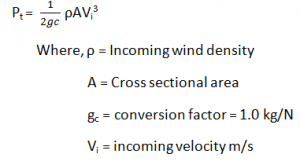This set of Energy Engineering Multiple Choice Questions & Answers (MCQs) focuses on “Velocity and Power from Wind”.
1. Select the formula for total power pt?
a) Pt = \(\frac{1}{2gc}\) ρAVi3
b) Pt = ρAVi3D3
c) Pt = \(\frac{1}{2gc}\) Vi3D3
d) Pt = \(\frac{2gc}{Vi^3}\)
View Answer
2. Why blade velocity of wind turbine varies?
a) Due to varying wind speeds
b) Long length of blades
c) Due to the height of mount
d) Because of hotness of Sun
View Answer
Explanation: Wind turbine experiences change in velocity dependent upon the blade inlet angle and the blade velocity. Since the blades are long, the blade velocity varies with the radius to a greater degree than steam or gas-turbine blades and the blades are therefore twisted.
3. When was the Halladay wind mill introduced?
a) 1920
b) 1923
c) 1854
d) 1864
View Answer
Explanation: Invented by Daniel Halladay in 1854, the Halladay Standard was the first commercially successful self-governing windmill in 1854 was the firms of Halladay, McCray & Co., Ellington, Conn. Partners in the company were inventor Daniel Halladay, John Burnham and Henry McCray.
4. How much ideal efficiency should practical turbine have?
a) 10 – 12%
b) 18 – 25%
c) 80 – 90%
d) 50 – 70%
View Answer
Explanation: As wind turbine wheel cannot be completely closed, and because of spillage and other effects, practical turbines have 50 to 70% of the ideal efficiency. The real efficiency η is the product of this and ηmax and is the ratio of an actual to total power.
P = ηPtot.
5. How many types are acting on propeller type wind mill?
a) 2
b) 3
c) 4
d) 5
View Answer
Explanation: There are two types of forces operating on the blades of a propeller type wind turbine. They are the circumferential forces in the direction of wheel rotation that provide the torque and the axial forces in the direction of the wind stream that provide an axial thrust that must be counteracted by proper mechanical design.
6. Calculate the air density, when 10m/s wind is at 1std atmospheric pressure and 15oC?
a) 1.226 kg/m3
b) 1.033 kg/m3
c) 2.108 kg/m3
d) 0.922 kg/m3
View Answer
Explanation: For air, gas constant R = 287 J/kgK, 1atm = 1.01325 X 105 Pa
Air density, ρ = P/RT = (1.01325 ×105)/(287(15+273.15)) = 1.226 kg/m3.
7. Calculate the air density when 18m/s wind is at 1std atmospheric pressure and 34oC?
a) 1.149 kg/m3
b) 1.9 kg/m3
c) 2.88 kg/m3
d) 5.89 kg/m3
View Answer
Explanation: For air, gas constant R = 287 J/kgK, 1atm = 1.01325 X 105 Pa
Air density, ρ = P/RT = (1.01325 × 105)/(287(34+273.15)) = 1.149 kg/m3.
8. What is the total power produced if the turbine diameter is 120m?
a) 0.277 KW
b) 1.224 KW
c) 4.28 KW
d) 0.89 KW
View Answer
Explanation: Total power P,
P = 0.245 X (πD2/4)
= 0.245 X (π (120)2/4)
= 0.277 KW.
9. What is the total power produced if the turbine diameter is 90m?
a) 0.155KW
b) 0.982 KW
c) 1.452 KW
d) 3.12 KW
View Answer
Explanation: Total power P,
P = 0.245 X (πD2/4)
= 0.245 X (π (90)2/4)
= 0.155KW.
Sanfoundry Global Education & Learning Series – Energy Engineering.
To practice all areas of Energy Engineering, here is complete set of 1000+ Multiple Choice Questions and Answers.
If you find a mistake in question / option / answer, kindly take a screenshot and email to [email protected]
- Check Energy Engineering Books
- Apply for Environmental Engineering Internship
- Practice Mechanical Engineering MCQs
- Apply for Mechanical Engineering Internship
- Practice Environmental Engineering MCQs

